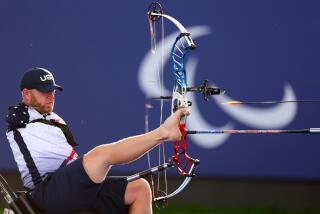THE FACTS ON . . . ARCHERY : ABOUT THE SPORT
There are two basic types of archery, target shooting and field archery.
In target shooting, distances are fixed and archers are allowed to use mechanical sights. In field archery, the distances vary and archers must use a bare bow.
In a target tournament, archers shoot at a multicolored target with five concentric circles, the one farthest from the center worth one point, the next worth three, then five, seven and finally the bull’s-eye, worth nine points.
Field archery competition is composed of three rounds with 28 shots per round. The first is the field round, in which archers shoot from distances of 11 to 80 yards at white-faced targets with five concentric black circles. In the hunters round, distances vary from 11 yards to 70 yards and the targets have black faces with five concentric white circles. In the animal round, archers shoot from 10 yards to 65 yards at targets with pictures of animals. These contain two scoring areas, one near the center of the animal and the other on the periphery.
San Diego archery clubs offer competitions on three skill levels in both target and field archery. A mechanical difference between target and field archery is the position of the archer’s hand--his anchor--before he releases the arrow. Target archers anchor under their chins, and field archers anchor on the side of their cheek.
Bow hunting is a type of field archery. Bows and arrows are used to shoot big game such as bear, elk and wild boars. Bow hunting is permitted anywhere hunting with a gun is permitted. Some communities require a minimum weight for the bow (the amount of force necessary to draw the bow) or restrict the size of the arrowhead when hunting certain animals.
People of all ages can compete in archery. Former state champion Dwayne Severn said he began when he was 13 or 14. Rube Powell, 75, a former five-time national freestyle champion, still shoots daily.
EQUIPMENT
Many archers use bows equipped with all sorts of high-tech gadgetry. Bows can have many different kinds of sights. They may also have cables and pulleys that help make it easier to draw the bow and allow the arrow to fly faster. Advanced archers may even use mechanical releases, instead of their fingers, to release the bowstring.
Bows are often made of fiberglass over a hardwood core or plastic. Arrows with aluminum shafts are more common than those made of of wood.
The result of this technology is increased accuracy. Archers using high-tech bows in tournaments, for example, can often achieve scores 20% higher than archers using more conventional bows.
In choosing a bow, an archer must determine its use and his strength.
Powell suggests that a novice begin with as simple equipment as possible.
A bow can cost as little as $165 or as much as $750. A dozen arrows cost around $35. A quiver to hold the arrows costs between $12 and $40. A tab, a glove worn on the release hand, costs around $7, and an arm guard around $6.
WHERE TO SHOOT
There are four archery clubs in San Diego County. The San Diego Archers have two ranges: the Alcazar Gardens in Balboa Park near the Laurel Street bridge and the Field Range at Morely Field. These ranges are open to the public every day, but the club shoots on the first Saturday and the third Sunday of each month.
The National City Turtle Archers share the Field Range with the San Diego Archers. They shoot on the second Sunday of each month.
The Bear State Bowhunters are located in Escondido, and there is also a club at Camp Pendleton. At all the club shooting cites, people may participate as visitors or may join the clubs.

